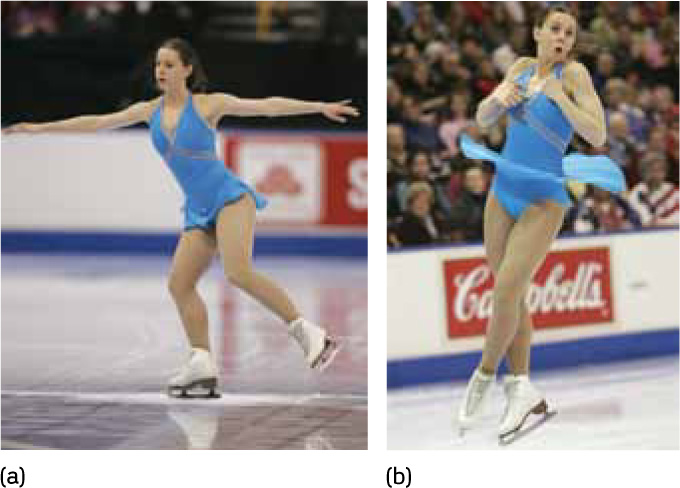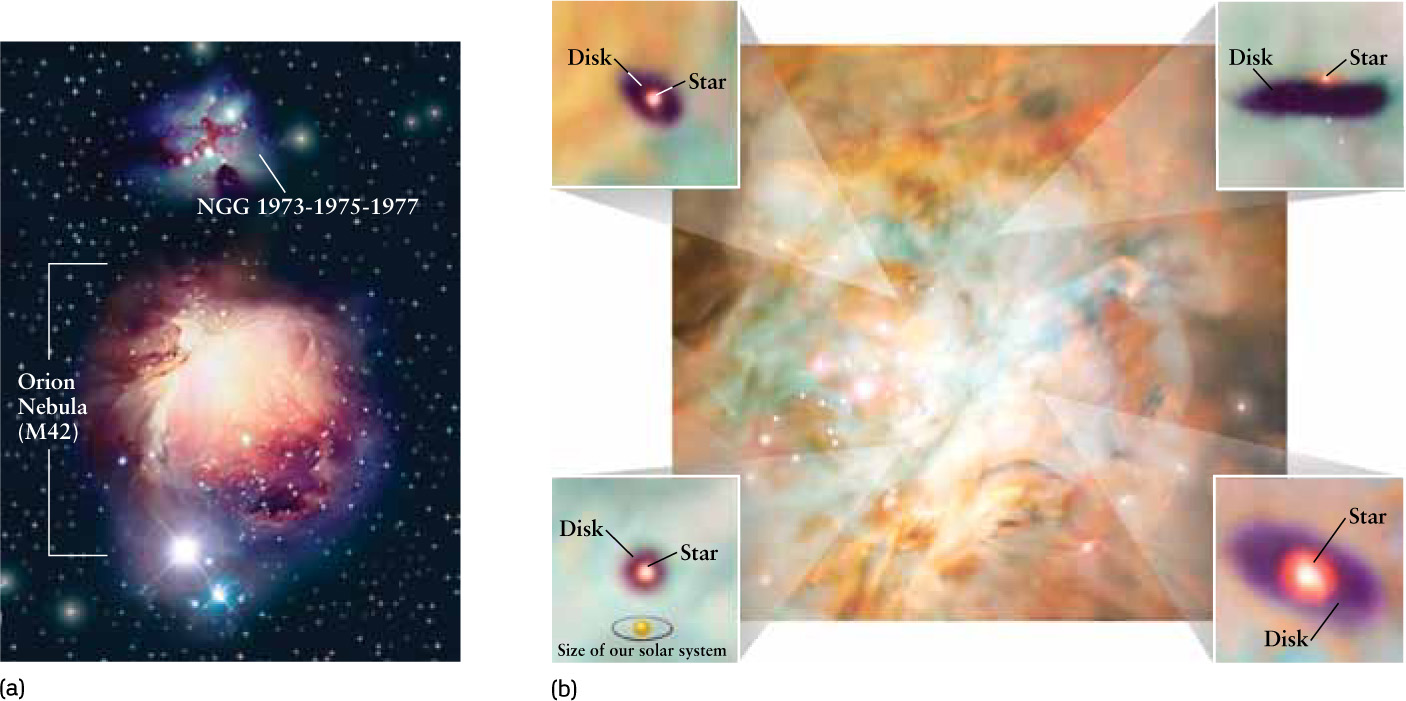8-4 The Sun and planets formed from a solar nebula
Astronomers see young stars that may be forming planets today in the same way that our solar system did billions of years ago
We have seen how processes in the Big Bang and within ancient stars produced the raw ingredients of our solar system. But given these ingredients, how did they combine to make the Sun and planets? Astronomers have developed a variety of models for the origin of the solar system. The test of these models is whether they explain the properties of the present-day system of Sun and planets.
The Failed Tidal Hypothesis
Any model of the origin of the solar system must explain why all the planets orbit the Sun in the same direction and in nearly the same plane (Property 2 in Table 8-1). One model that was devised explicitly to address this issue was the tidal hypothesis, proposed in the early 1900s. As we saw in Section 4-8, two nearby planets, stars, or galaxies exert tidal forces on each other that cause the objects to elongate. In the tidal hypothesis, another star happened to pass close by the Sun, and the star’s tidal forces drew a long filament out of the Sun. The filament material would then go into orbit around the Sun, and all of it would naturally orbit in the same direction and in the same plane. From this filament the planets would condense. However, it was shown in the 1930s that the same tidal forces strong enough to pull a filament out of the Sun would also cause the filament to disperse before it could condense into planets. Hence, the tidal hypothesis cannot be correct.
The Successful Nebular Hypothesis

An entirely different model is now thought to describe the most likely series of events that led to our present solar system (Figure 8-6). The central idea of this model dates to the late 1700s, when the German philosopher Immanuel Kant and the French scientist Pierre-Simon de Laplace turned their attention to the manner in which the planets orbit the Sun. Both concluded that the arrangement of the orbits—all in the same direction and in nearly the same plane—could not be mere coincidence. To explain the orbits, Kant and Laplace independently proposed that our entire solar system, including the Sun as well as all of its planets and satellites, formed from a vast, rotating cloud of gas and dust called the solar nebula (Figure 8-6a). This model is called the nebular hypothesis.
The consensus among today’s astronomers is that Kant and Laplace were exactly right. In the modern version of the nebular hypothesis, at the outset the solar nebula was similar in character to the nebulosity shown in Figure 8-3 and had a mass somewhat greater than that of our present-day Sun.
Each part of the nebula exerted a gravitational attraction on the other parts, and these mutual gravitational pulls tended to make the nebula contract. As it contracted, the greatest concentration of matter occurred at the center of the nebula, forming a relatively dense region called the protosun. As its name suggests, this part of the solar nebula eventually developed into the Sun. The planets formed from the much sparser material in the outer regions of the solar nebula. Indeed, the mass of all the planets together is only 0.1% of the Sun’s mass.
Evolution of the Protosun
When you drop a ball, the gravitational attraction of Earth makes the ball fall faster and faster as it falls; in the same way, material falling inward toward the protosun would have gained speed as it approached the center of the solar nebula. As this fast-moving material ran into the protosun, the kinetic energy of the collision was converted into thermal energy, causing the temperature deep inside the solar nebula to climb. This process, in which the gravitational energy of a contracting gas cloud is converted into thermal energy, is called Kelvin-Helmholtz contraction, after the nineteenth-century physicists who first described it.
As the newly created protosun continued to contract and become denser, its temperature continued to climb as well. After about 105 (100,000) years, the protosun’s surface temperature stabilized at about 6000 K, but the temperature in its interior kept increasing to ever higher values as the central regions of the protosun became denser and denser. Eventually, after perhaps 107 (10 million) years had passed since the solar nebula first began to contract, the gas at the center of the protosun reached a density of about 105 kg/m3 (about 13 times denser than typical iron) and a temperature of a few million kelvins (that is, a few times 106 K). Under these extreme conditions, nuclear reactions that convert hydrogen into helium began in the protosun’s interior. These nuclear reactions released energy that significantly increased the pressure in the protosun’s core. When the pressure built up enough, it stopped further contraction of the protosun and a true star was born. In fact, the onset of nuclear reactions defines the end of a protostar and beginning of a star. Nuclear reactions continue to the present day in the interior of the Sun and are the source of all the energy that the Sun radiates into space.
The Protoplanetary Disk
If the solar nebula had not been rotating at all, everything would have fallen directly into the protosun, leaving nothing behind to form the planets. Instead, the solar nebula must have had an overall slight rotation, which caused its evolution to follow a different path. As the slowly rotating nebula collapsed inward, it would naturally have tended to rotate faster. This relationship between the size of an object and its rotation speed is an example of a general principle called the conservation of angular momentum.
ANALOGY
Figure skaters make use of the conservation of angular momentum. When a spinning skater pulls her arms and legs in close to her body, the rate at which she spins automatically increases (Figure 8-7). Even if you are not a figure skater, you can demonstrate this by sitting on a rotating office chair. Sit with your arms outstretched and hold a weight, like a brick or a full water bottle, in either hand. Now use your feet to start your body and the chair rotating, lift your feet off the ground, and then pull your arms inward. Your rotation will speed up quite noticeably.

Conservation of Angular Momentum A figure skater who (a) spins slowly with her limbs extended will naturally speed up when (b) she pulls her limbs in. In the same way, the solar nebula spun more rapidly as its material contracted toward the center of the nebula.
Astronomers see young stars that may be forming planets today in the same way that our solar system did billions of years ago. As the solar nebula began to rotate more rapidly, it also tended to flatten out (Figure 8-6b)—but why? From the perspective of a particle rotating along with the nebula, it felt as though there were a force pushing the particle away from the nebula’s axis of rotation. (Likewise, passengers on a merry-go-round or spinning carnival ride seem to feel a force pushing them outward and away from the ride’s axis of rotation.) This apparent force was directed opposite to the inward pull of gravity, and so it tended to slow the contraction of material toward the nebula’s rotation axis. But there was no such effect opposing contraction in a direction parallel to the rotation axis. Some 105 (100,000) years after the solar nebula first began to contract, it had developed the structure shown in Figure 8-6b, with a rotating, flattened disk surrounding what will become the protosun. This disk is called the protoplanetary disk, since planets formed from its material. This model explains why their orbits all lie in essentially the same plane and why they all orbit the Sun in the same direction.
There were no humans to observe these processes taking place during the formation of the solar system. But Earth astronomers have seen disks of material surrounding other stars that formed only recently. These, too, are called protoplanetary disks, because it is thought that planets can eventually form from these disks around other stars. Hence, these disks are planetary systems that are still “under construction.” By studying these disks around other stars, astronomers are able to examine what our solar nebula may have been like some 4.5 × 109 years ago.
Figure 8-8 shows a number of protoplanetary disks in the Orion Nebula, a region of active star formation. A star is visible at the center of each disk, which reinforces the idea that our Sun began to shine before the planets were fully formed. (The images that open this chapter show even more detailed views of disks surrounding young stars.) A study of 110 young stars in the Orion Nebula detected protoplanetary disks around 56 of them, which suggests that systems of planets may form around a substantial fraction of stars. Later in this chapter we will see direct evidence for planets that have formed around stars other than the Sun.

 Protoplanetary Disks (a) The Orion Nebula is a star-forming region located some 1500 light-years from Earth. It is the middle “star” in Orion’s “sword” (see Figure 2-2a). The smaller, bluish nebula is the object shown in Figure 8-3. (b) This view of the center of the Orion Nebula is a mosaic of Hubble Space Telescope images. The four insets are false-color close-ups of four protoplanetary disks that lie within the nebula. A young, recently formed star is at the center of each disk. (The disk at upper right is seen nearly edge-on.) The inset at the lower left shows the size of our own solar system for comparison.
Protoplanetary Disks (a) The Orion Nebula is a star-forming region located some 1500 light-years from Earth. It is the middle “star” in Orion’s “sword” (see Figure 2-2a). The smaller, bluish nebula is the object shown in Figure 8-3. (b) This view of the center of the Orion Nebula is a mosaic of Hubble Space Telescope images. The four insets are false-color close-ups of four protoplanetary disks that lie within the nebula. A young, recently formed star is at the center of each disk. (The disk at upper right is seen nearly edge-on.) The inset at the lower left shows the size of our own solar system for comparison.
CONCEPT CHECK 8-5
If the nebular hypothesis is correct, what must it explain about the planetary orbits?
To be correct, the nebular hypothesis must explain why all the planets orbit the Sun in the same direction and in nearly the same plane. This arrangement is unlikely to have arisen purely by chance.
CONCEPT CHECK 8-6
Was the solar nebula cold until nuclear reactions began powering the Sun?
No. Through Kelvin-Helmholtz contraction, gravitational energy is converted into heat—a lot of heat. The protosun, which formed before nuclear reactions began, had a surface temperature of 6000 K, slightly higher than our present-day Sun. Thus, the solar nebula was warmed by the protosun.